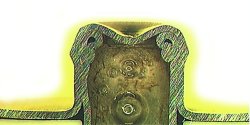|
by
E. E. Bliley, Lucent
Technologies
When ESD wristband
snaps disconnecting from the coiled ground cords became a persistent
problem for one manufacturing line, a thorough investigation
revealed the culprit—the stud snap on the buckle. More specifically,
a direct correlation was discovered between the breakaway force and
the unintentional disconnects for formed snaps vs. machined
snaps.
The solution
resulted in an improved ESD process as well as a reduction in the
cost of wristband and coil-cord products for Lucent Technologies in
Columbus, OH. In this 2.2 million square feet facility,
approximately 5,200 employees are engaged in manufacturing wireless
telecommunications equipment deployed throughout the world. An
estimated 3,000 ESD-protected workstations are located in 39
separate manufacturing areas.
All employees are
trained in ESD control per Lucent corporate requirements. Each
employee is recertified at a maximum of 24 months. Control of ESD is
accomplished through wrist straps, static-dissipative work surfaces,
grounded workstations, and proper handling of static-generating
material.
The Problem
Unfolds
In April 1999, a
high-performance team on the second shift asked the ESD coordinator
to help solve a functionality problem with wristbands. The team
reported that the coiled ground cord was easily disconnected from
the wristband. Sometimes the accidental snap release was discovered
immediately, but more often it was several minutes later.
This problem
puzzled the ESD coordinator who had been in his position for nearly
four years. Why had this problem not surfaced earlier? After a
couple of meetings with the team, the ESD coordinator decided the
concern was valid and started an investigation to determine the
magnitude of the problem.
Analysis
Production
associates began keeping records on the frequency of accidental snap
releases over a given period of time. Each of the 16 associates
recorded the number of unintentional disconnects over a 21-day
period. During the study period, 241 unintentional disconnects were
experienced by the team members. This data yielded an average of
0.72 releases per person per day and substantiated the magnitude of
the problem.
Since four
employees had zero disconnects, analysis of their work patterns was
conducted to determine if undue stretching of the cord and/or
excessive mobility might be responsible for the accidental releases.
This study showed that employees seated at test sets had the fewest
releases.
A dimensional
analysis was conducted to determine if the stud on the wristband
might be the problem. The shank, minimum diameter, and the head,
maximum diameter, were measured and the data analyzed. In many
cases, the analysis noted that the difference between the two
diameters was only a few thousandths of an inch. This finding
convinced the ESD coordinator that a real problem existed and
further investigation was warranted.
The supplier of the
ground cords and wristbands was contacted to discuss the breakaway
force specification. The supplier maintained that its breakaway
force specification ranged between 0.5 and 5.0 lb.
This specification
was compared to the ESD Association ESD-S1.1 Standard for Protection
of Electrostatic Discharge Sensitive Items: Personnel Grounding
Wrist Straps. It states that “at least 1 pound but not more than 5
pounds of breakaway force applied to the ground lead in the normal
disconnect direction shall be required to cause
separation.”
The supplier was
asked to provide breakaway force data on a sample of wristbands and
ground cords from recent production. Figure 1 is a line chart of that
data.
Analysis of the
data showed that one-third or 15 of 45 band/cord combinations had a
breakaway force of less than 1.0 lb. The average breakaway force was
1.52 lb, and the standard deviation of the sample was 0.96
lb.
Another supplier
suggested that an alternate wristband be evaluated. The supplier
hypothesized that a wristband with a machined stud would provide the
dimensional properties necessary not only to meet ESD-S1.1, but also
to alleviate a large portion of the unintentional disconnects. The
new supplier provided the breakaway force data on sample bands with
machined snaps, which appears in Figure 2.
Analysis of the
data for wristbands with machined snaps showed an average of 3.22 lb
breakaway force and a standard deviation of 0.30 lb. Only one
band/cord combination had a breakaway force of less than that
prescribed in ESD-S1.1.
Further analysis
was conducted to explain the difference in breakaway force data
between formed snaps (the snaps currently in use) and the machined
snaps with an average approximately twice as high.
Formed snaps are
fabricated by a stamping operation of the two pieces that eventually
will become the assembled snap. Machined snaps are exactly what the
name implies. They are machined on automated equipment from
stainless steel rod stock. A sample of each snap was mounted,
cross-sectioned, and lapped for analysis.
 Figure 3 (right) illustrates a cross section of the two
pieces of a formed snap after assembly onto a wristband. The
riveting operation produced significant distortion of the snap head
and body. This profile is responsible for the lower breakaway force
distribution shown in Figure 1. Figure 3 (right) illustrates a cross section of the two
pieces of a formed snap after assembly onto a wristband. The
riveting operation produced significant distortion of the snap head
and body. This profile is responsible for the lower breakaway force
distribution shown in Figure 1.
 Figure 4 (right) is the cross section of a machined
snap. Because of the solid construction and precise machining, it
appears completely different than the formed snap and explains the
corresponding difference in the breakaway force
distributions. Figure 4 (right) is the cross section of a machined
snap. Because of the solid construction and precise machining, it
appears completely different than the formed snap and explains the
corresponding difference in the breakaway force
distributions.
The ESD coordinator
was convinced that the machined snaps were superior. He purchased
new wristbands for each second-shift team member and conducted
another evaluation. Employees were allowed to retain their standard
ground cords. As before, each person was asked to record all
accidental snap releases for the study period.
Results
During the 28-day
evaluation period, a total of 31 unintentional disconnects was
experienced by 15 participants. This yielded an average of 0.07
releases per person per day and represented an order of magnitude
improvement; however, a complete solution to the problem had not
been found. Further investigation was necessary to determine if the
disconnects were the result of using the standard ground cord with
the new wristbands.
Ground cords from
the same manufacturer that supplied the machine-snap wristbands were
purchased, and a third factory test was conducted for a period of 32
days. During this time, using machine-snap wristbands and ground
cords from the same supplier, there were no accidental releases. The
team was convinced that a complete solution to the problem had been
realized. Purchasing requirements were changed to specify wristbands
with machined snaps and the new high-reliability ground
cords.
Conclusion
The ESD program
manager learned that employee input is crucial to continuously
improve the process. He had nearly dismissed their claims that
unintentional disconnects were a problem. Together, the team found
the problem was much larger than just one department on second
shift.
As improvements
were forthcoming, many employees indicated that they had experienced
the same problem. Some employees said they had tied a loop in the
ground cord around the wristband to provide a strain
relief.
Not only was the
ESD process improved, but the wristbands with machined snaps and the
high-reliability ground cords also were less expensive than the
formed-snap products previously used.
Recommendation to
ESD Coordinators
- Listen honestly
to your team members, take their complaints seriously, and strive
to create an atmosphere where people feel comfortable bringing
information forward.
- Be willing to
reevaluate previously approved items and seek out best-in-class
products.
- Realize that ESD
programs are continuous improvement processes, not a one-time
event that is established and forgotten.
- Partner with
suppliers and share your concerns and problems with them. They can
help identify the reality of problems and suggest possible
solutions.
Acknowledgements
The author
expresses his appreciation to each team member who participated in
this project. He also thanks his engineering and supplier colleagues
for their support and contributions.
About the
Author
Gene Bliley
manages the ESD program at the Lucent Technologies facility in Columbus. He also
is a member of Lucent’s Global Leadership Team and the ESD Task
Group and serves as co-chairman of the corporate ESD Control
Subcommittee. Lucent Technologies, 6200 E. Broad St., Columbus, OH
43213, 614-860-5873, e-mail: bliley@lucent.com.
Return to EE Home Page
Published by
EE-Evaluation Engineering
All contents © 2001 Nelson Publishing
Inc.
No reprint, distribution, or reuse in any medium is
permitted
without the express written consent of the
publisher.
*Reproduced with
Permission,
EE-Evaluation
Engineering
|